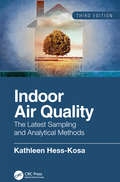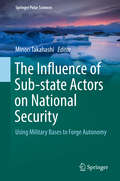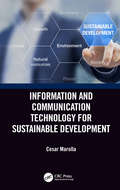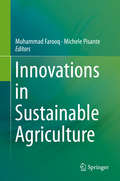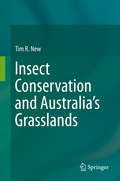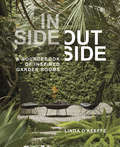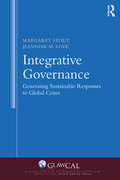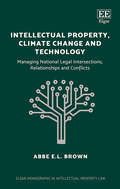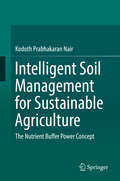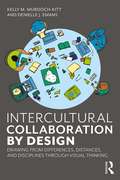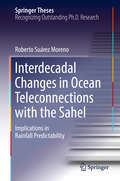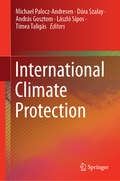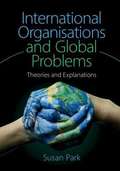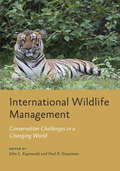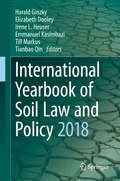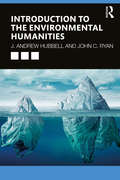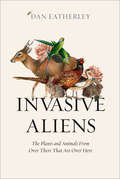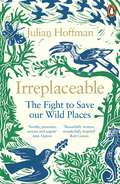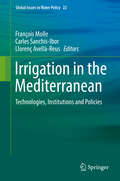- Table View
- List View
Indoor Air Quality: The Latest Sampling and Analytical Methods, Third Edition
by Kathleen Hess-KosaIndoor Air Quality: The Latest Sampling and Analytical Methods, Third Edition is a practical, user-friendly guide to the identification and assessment of the indoor air contaminants that contribute to building-related illness in commercial buildings, institutions, and residences. It covers the basic concepts of indoor air quality assessment, including its historic evolution. The book describes the most common substances encountered in an indoor air quality investigation, their health effects, and their occurrence in the environment. Drawing from the author’s experience, observations, and extensive research, this easy-to-read guide provides readers with a working knowledge of the latest approaches to sampling protocols and cutting-edge trends as well as suggested sampling strategies, helpful experience related tips, and a means for interpreting results. Additionally, in the later part of the book, there is considerable discussion of failure modes of building materials and systems—sources of many indoor air quality problems! This third edition details up-to-date strategies and analytical methods and addresses some of the more recent, as well as less common, concerns on indoor air pollutants. All chapters in the third edition have been updated to adhere to the more recent developments in indoor air quality. Also a new chapter on the illusive data and sampling approaches on ozone has been added. New in the Third Edition Revised and updated standards and guidelines Updated U.S. EPA NAAQS Updated LEEDv4 Standard Updated ANSI/ASHRAE Standard 189.1 Latest approaches to sampling and analytical methods Expanded discussion on controversial inhalable airborne particulate sampling methods Updated and expanded tables and data Updated and expanded figures and schematics Inclusion of a new chapter on ozone
Indoor Air Quality: The Latest Sampling and Analytical Methods, Third Edition
by Kathleen Hess-KosaIndoor Air Quality: The Latest Sampling and Analytical Methods, Third Edition is a practical, user-friendly guide to the identification and assessment of the indoor air contaminants that contribute to building-related illness in commercial buildings, institutions, and residences. It covers the basic concepts of indoor air quality assessment, including its historic evolution. The book describes the most common substances encountered in an indoor air quality investigation, their health effects, and their occurrence in the environment. Drawing from the author’s experience, observations, and extensive research, this easy-to-read guide provides readers with a working knowledge of the latest approaches to sampling protocols and cutting-edge trends as well as suggested sampling strategies, helpful experience related tips, and a means for interpreting results. Additionally, in the later part of the book, there is considerable discussion of failure modes of building materials and systems—sources of many indoor air quality problems! This third edition details up-to-date strategies and analytical methods and addresses some of the more recent, as well as less common, concerns on indoor air pollutants. All chapters in the third edition have been updated to adhere to the more recent developments in indoor air quality. Also a new chapter on the illusive data and sampling approaches on ozone has been added. New in the Third Edition Revised and updated standards and guidelines Updated U.S. EPA NAAQS Updated LEEDv4 Standard Updated ANSI/ASHRAE Standard 189.1 Latest approaches to sampling and analytical methods Expanded discussion on controversial inhalable airborne particulate sampling methods Updated and expanded tables and data Updated and expanded figures and schematics Inclusion of a new chapter on ozone
The Influence of Sub-state Actors on National Security: Using Military Bases to Forge Autonomy (Springer Polar Sciences)
by Minori TakahashiThis book sheds light on the process in which the sub-state actor of Greenland has expanded its autonomy and strengthened its de jure participation in the national security of Denmark. By focusing on the case of the US Thule Air Base in Greenland, the largest military base in the Arctic, the authors endeavor to show that in the relationship between great powers, small countries and local actors within them, it is possible for local actors (sub-national entities) to have an influence on higher-level actors in the field of diplomacy on the national security level. For that purpose, the book examines political trends involving Greenland, Denmark, the US and Russia by using the multilateral multi-archive approach. The authors also take up the cases of Okinawa (Japan) and Olongapo (the Philippines) as reference points that provide additional insight into the interaction between the US policy regarding overseas military bases and the host countries’ polities. The competition involving political and economic interests of a number of countries in the Arctic region has been intensifying in recent years, causing significant concern in the international community. Due to the accelerated melting of sea ice and the increase in the accessibility of natural resources and water lanes, the security situation in the Arctic has been changing rapidly, and this book helps meet the need for understanding the political and military factors behind those changes.
Information and Communication Technology for Sustainable Development
by Cesar MarollaInformation and Communication Technology for Sustainable Development shows how ICT, as an enabler for all spheres of development, can help innovate business processes and operations, and provide faster integration of new technologies into business systems. Focused on sustainability, the book addresses strategic approaches to cope with a range of climatic, environmental, cyber-security threats and other global risks, and aims to promote prosperity and economic growth. Furthermore, it explores how the adoption of new technologies, and collective action based upon a strategic behavioral theory of new leadership, can be applied when responding to specific set of conditions that allow for the proposed strategies to cope with risks. Information technology and strategic planning complement each other to attain the sustainable development goals (SDGs). Risk management frameworks, business continuity systems, and strategic planning methodologies such as mechanism design theory, strategic adaptive cognition (SAC), and risk mechanism theory (RMT) are the fundamental components needed to have a universal approach embedded into the national development plans agenda. As technology no longer follows an orderly, linear path, but improves exponentially, developing a strategic approach to ICT implementation help world leaders in the difficult but inspiring task of making a sustainable world and consequently find solutions to achieve the SDGs and the desired growth pattern that must be sustained, inclusive and equitable. Features: Discusses for the first time the potential of ICT as a transformative power in finding solutions to climatic and economic issues. Illustrates comprehensive strategic planning for leaders to implement in both public and private organizations. Integrates standards and frameworks in the context of sustainable development along with the UN Sustainable Development Goals. Describes in detail how mechanism design, risk management, business continuity systems, a comprehensive strategic planning using SAC (Strategic Adaptive Cognition) and risk mechanism theory can be used to address environmental risks and attain sustainable development goals (SDGs). Explains eHealth as an adaptation strategy to address future changes in climate and impacts, and the links between mitigation and adaptation to ICTs.
Information and Communication Technology for Sustainable Development
by Cesar MarollaInformation and Communication Technology for Sustainable Development shows how ICT, as an enabler for all spheres of development, can help innovate business processes and operations, and provide faster integration of new technologies into business systems. Focused on sustainability, the book addresses strategic approaches to cope with a range of climatic, environmental, cyber-security threats and other global risks, and aims to promote prosperity and economic growth. Furthermore, it explores how the adoption of new technologies, and collective action based upon a strategic behavioral theory of new leadership, can be applied when responding to specific set of conditions that allow for the proposed strategies to cope with risks. Information technology and strategic planning complement each other to attain the sustainable development goals (SDGs). Risk management frameworks, business continuity systems, and strategic planning methodologies such as mechanism design theory, strategic adaptive cognition (SAC), and risk mechanism theory (RMT) are the fundamental components needed to have a universal approach embedded into the national development plans agenda. As technology no longer follows an orderly, linear path, but improves exponentially, developing a strategic approach to ICT implementation help world leaders in the difficult but inspiring task of making a sustainable world and consequently find solutions to achieve the SDGs and the desired growth pattern that must be sustained, inclusive and equitable. Features: Discusses for the first time the potential of ICT as a transformative power in finding solutions to climatic and economic issues. Illustrates comprehensive strategic planning for leaders to implement in both public and private organizations. Integrates standards and frameworks in the context of sustainable development along with the UN Sustainable Development Goals. Describes in detail how mechanism design, risk management, business continuity systems, a comprehensive strategic planning using SAC (Strategic Adaptive Cognition) and risk mechanism theory can be used to address environmental risks and attain sustainable development goals (SDGs). Explains eHealth as an adaptation strategy to address future changes in climate and impacts, and the links between mitigation and adaptation to ICTs.
Innovations in Sustainable Agriculture
by Muhammad Farooq Michele PisanteThis volume is a ready reference on sustainable agriculture and reinforce the understanding for its utilization to develop environmentally sustainable and profitable food production systems. It describes ecological sustainability of farming systems, present innovations for improving efficiency in the use of resources for sustainable agriculture and propose technological options and new areas of research in this very important area of agriculture.
Insect Conservation and Australia’s Grasslands
by Tim R. NewAustralia’s varied grasslands have suffered massive losses and changes since European settlement, and those changes continue under increasingly intensive human pressures for development and agricultural production. The values of native grasslands for conservation of endemic native biodiversity, both flora and fauna, have led to strong interests in the protection of remaining fragments, especially near urban centres, and documentation of the insects and other inhabitants of grasslands spanning tropical to cool temperate parts of the country. Attention to conservation of grassland insects in Australia is relatively recent, but it is increasingly apparent that grasslands harbour many localised and ecologically specialised endemic species. Their conservation necessarily advances from very incomplete documentation, and draws heavily on lessons from the far better-documented grasslands elsewhere, most notably in the northern hemisphere, and undertaken over far longer periods. From those cases, and the extensive background to grassland management to harmonise conservation with production and amenity values through honing use of processes such as grazing, mowing and fire, the needs and priorities for Australia can become clearer, together with needs for grassland restoration at a variety of scales. This book is a broad overview of conservation needs of grassland insects in Australia, drawing on the background provided elsewhere in the world on the responses to disturbances, and the ecological importance, of some key insect groups (notably Orthoptera, Hemiptera and Lepidoptera) to suggest how insect conservation in native, pastoral and urban grasslands may be advanced. The substantial references given for each chapter facilitate entry for non-entomologist grassland managers and stewards to appreciate the diversity and importance of Australia’s grassland insects, their vulnerabilities to changes, and the possibilities for conserving them and the wider ecological roles in which they participate.
Inside Outside: A Sourcebook of Inspired Garden Rooms
by Linda O'KeeffeUsing the principles and language of interior design, Inside Outside offers a fresh and inspirational look at creating inviting, beautiful, and personalized outdoor rooms.
Insomnia
by John KinsellaThe Australian poet John Kinsella’s vivid and urgent new collection addresses the crisis of being that currently afflicts us: Kinsella addresses a situation where the creations of the human imagination, the very means by which we extend our empathies into the world – art, music and philosophy – suddenly find themselves in a world that not only denies their importance, but can sometimes seem to have no use for them at all. In an attempt to find a still point from which we might reconfigure our perspective and address the paradoxes of our contemporary experience, Kinsella has written poems of self-accusation and angry protest, meditations on the nature of loss and trauma, and full-throated celebrations of the natural world. Ranging from Jam Tree Gully, Western Australia to the coast of West Cork, Ireland, haunted by historical and literary figures from Dante to Emily Brontë (whom Kinsella has obsessed over since he was a child, and who intervenes in the poet’s attempts to come to grips with ideas of colonization and identity), Insomnia may be Kinsella’s most various and powerful collection to date.
Integrative Governance: Generating Sustainable Responses To Global Crises (Global Law and Sustainable Development)
by Margaret Stout Jeannine M. LoveDominant governance theories are drawn primarily from Euro-American sources, including emergent theories of network and collaborative governance. The authors contest this narrow view and seek a more globally inclusive and transdisciplinary perspective, arguing such an approach is more fruitful in addressing the wicked problems of sustainability—including social, economic, and environmental crises. This book thus offers and affirms an innovative governance approach that may hold more promise as a "universal" framework that is not colonizing in nature due to its grounding in relational process assumptions and practices. Using a comprehensive Governance Typology that encompasses ontological assumptions, psychosocial theory, epistemological concepts, belief systems, ethical concepts, political theory, economic theory, and administrative theory, the authors delve deeply into underlying philosophical commitments and carry them into practice through an approach they call Integrative Governance. The authors consider ways this approach to radical self-governance is already being implemented in the prefigurative politics of contemporary social movements, and they invite scholars and activists to: imagine governance in contexts of social, economic, and environmental interconnectedness; to use the ideal-type as an evaluative tool against which to measure practice; and to pursue paradigmatic change through collaborative praxis.
Integrative Governance: Generating Sustainable Responses to Global Crises (Global Law and Sustainable Development)
by Margaret Stout Jeannine M. LoveDominant governance theories are drawn primarily from Euro-American sources, including emergent theories of network and collaborative governance. The authors contest this narrow view and seek a more globally inclusive and transdisciplinary perspective, arguing such an approach is more fruitful in addressing the wicked problems of sustainability—including social, economic, and environmental crises. This book thus offers and affirms an innovative governance approach that may hold more promise as a "universal" framework that is not colonizing in nature due to its grounding in relational process assumptions and practices. Using a comprehensive Governance Typology that encompasses ontological assumptions, psychosocial theory, epistemological concepts, belief systems, ethical concepts, political theory, economic theory, and administrative theory, the authors delve deeply into underlying philosophical commitments and carry them into practice through an approach they call Integrative Governance. The authors consider ways this approach to radical self-governance is already being implemented in the prefigurative politics of contemporary social movements, and they invite scholars and activists to: imagine governance in contexts of social, economic, and environmental interconnectedness; to use the ideal-type as an evaluative tool against which to measure practice; and to pursue paradigmatic change through collaborative praxis.
Intellectual Property, Climate Change and Technology: Managing National Legal Intersections, Relationships and Conflicts (Elgar Monographs in Intellectual Property Law)
by Abbe E.L. BrownExploring the potential for alignment as well as conflicts between IP and climate change, Intellectual Property, Climate Change and Technology encourages a coherent and integrated approach to decision making. This groundbreaking book identifies and challenges the lack of intersection between intellectual property law and climate change law at national level. It argues that intellectual property confers private rights on the results of innovation and creativity, while climate change law and policy exists more in the public sphere without engagement with intellectual property, with no space for the conflict between this private power and public goal to be investigated in litigation. This thought-provoking book will be of great interest to scholars working in the fields of IP, climate change law, human rights, investor–state dispute settlement, and planning and sustainable development, challenging the assumption that some problems are dealt with only through consideration of certain areas of the law. Proposing new processes for policy and law making in order to remove barriers between these fields, Intellectual Property, Climate Change and Technology will also be a valuable resource for members of parliament and policy makers.
Intelligent Soil Management for Sustainable Agriculture: The Nutrient Buffer Power Concept
by Kodoth Prabhakaran NairThis book conceptualizes a revolutionary idea based on a mechanistic-mathematical model in which the “Buffer Power” of the principal and problematic nutrients like phosphorus, potassium and zinc is quantified. This is achieved by using either a very sophisticated technique, electro-ultra-filtration, or a simple adsorption-desorption equilibrium technique, and by integrating the “Buffer Power” of the nutrient in question into the computations, accurate fertilizer recommendations are made. This technique was field tested across Europe, (Germany and Belgium), Africa (The Republic of Cameroon), and Asia (both Central Asia- Turkey and South Asia-India), during a period of three decades in test crops, such as, summer rye (Secale cereale), maize (Zea mays), wheat (Triticum aestivum), white clover (Trifolium repens), a highly nutritious and palatable fodder crop for Africa, black pepper (Piper nigrum) and cardamom (Elettaria cardamomum). Remarkable precision in predictability of plant uptake of phosphorus, potassium and zinc was obtained employing the technique.“The Nutrient Buffer Power Concept” project was shortlisted for the very prestigious U.S. $1 Million Rolex Awards For Enterprise of The Rolex Foundation, Geneva, Switzerland, for its outstanding originality and quality from more than 3500 nominations worldwide and is the only project chosen for this very coveted distinction from the Asian continent.
Intercultural Collaboration by Design: Drawing from Differences, Distances, and Disciplines Through Visual Thinking
by Kelly Murdoch-Kitt Denielle EmansIntercultural Collaboration by Design introduces a framework for collaborating across cultures and learning to use multicultural perspectives to address pressing global issues. This handbook helps people work, learn, and teach across cultures. Through the activities highlighted in this book, virtual and intercultural teams will find a practical route for initiating and sustaining productive work across disciplinary and social barriers. Teams can craft a plan to achieve their goals by selecting the activities that best meet their needs and interests. First-person anecdotes from the authors demonstrate how the activities encourage teams to embrace diverse perspectives in order to create innovative solutions. With over 30 hands-on activities, this book will be of great interest to diverse teams from a variety of disciplines who want to enhance intercultural learning and co-working. Whether in the classroom or workplace, the activities are appropriate for a variety of collaboration contexts, without a need for background in art or design.
Interdecadal Changes in Ocean Teleconnections with the Sahel: Implications in Rainfall Predictability (Springer Theses)
by Roberto Suárez MorenoIn tropical latitudes, monsoons trigger regimes of strong seasonal rainfall over the continents. Over the West African region, the rainfall has shown a strong variability from interannual to decadal time scales. The atmospheric response to global sea surface temperatures is the leading cause of rainfall variability in the West African Sahel. This thesis explores changes in the leading ocean forcing of Sahelian rainfall interannual variability. It anaylzes the dynamical mechanisms at work to explain the non-stationary sea surface temperature-forced response of anomalous rainfall. The underlying multidecadal sea surface temperature background is raised as a key factor that favors some interannual teleconnections and inhibits others. Results of this thesis are relevant for improving the seasonal predictability of summer rainfall in the Sahel.
International Climate Protection
by Michael Palocz-Andresen Dóra Szalay András Gosztom László Sípos Tímea TaligásThis book explains the current climate protection processes and technologies, and informs the readers of the limiting factors and opportunities for future development. It represents the highest level of knowledge from leading scientists all over the world. Original high quality figures maximize understanding of the text. The book also introduces a new concept (climatographic), which provides a well pronounced solution to climate protection that is easily understandable for all levels of readers.
International Organisations And Global Problems (PDF): Theories And Explanations
by Susan ParkInternational organisations (IOs) are considered fundamental in addressing global problems, but how effective are they? Conflict (war), human rights, global health, financial governance, international trade, regionalisation, development and the environment are all issues that international organisations have been created to address. This book looks at these eight key issue areas and guides the reader through an analysis of the successes and failures of international organisations in solving issues in global politics. With an introduction to international relations theory, it incorporates the best and most up-to-date scholarly research, and applies it to examples from around the world to show how to answer the question, 'Are IOs a help or a hindrance?' This textbook is an essential resource for courses on global governance, international organisations and international relations. Including an expanded further reading list for each global issue, as well as a thorough bibliography of the most up-to-date research, this is a resource that will be useful during study and on into the future.
International Wildlife Management: Conservation Challenges in a Changing World (Wildlife Management and Conservation)
by John L. Koprowski Paul R. KrausmanHabitat loss, disease management, predator-human conflict, illegal trade—these are among the many conservation challenges faced by wildlife experts around the world. But how wildlife professionals approach these issues has historically been geographically fragmented. By providing a broad perspective on issues faced by wildlife on an international scale, the authors of International Wildlife Management make vital connections, drawing attention to underlying causes and strategies for mitigation that may look surprisingly similar from Montana to Zimbabwe. Bringing together wildlife professionals from around the globe to discuss shared challenges, International Wildlife Management• examines widespread patterns of wildlife loss• covers key conservation strategies, including species reintroduction, community engagement, and wildlife commerce• explores the urgent concerns of climate change, habitat loss and fragmentation, invasive species, and poaching• reviews major organizations involved in wildlife management at an international level, highlighting examples of cooperation among groups and nations in effective wildlife management efforts• features stories of success and struggle from authors across 17 countries on 6 continents This timely and thorough overview thinks big by assessing threats to wildlife on a global scale. Wild creatures don't recognize artificial geographic borders. This useful compendium demonstrates that researchers and scientists should follow their lead.
International Wildlife Management: Conservation Challenges in a Changing World (Wildlife Management and Conservation)
by John L. Koprowski Paul R. KrausmanHabitat loss, disease management, predator-human conflict, illegal trade—these are among the many conservation challenges faced by wildlife experts around the world. But how wildlife professionals approach these issues has historically been geographically fragmented. By providing a broad perspective on issues faced by wildlife on an international scale, the authors of International Wildlife Management make vital connections, drawing attention to underlying causes and strategies for mitigation that may look surprisingly similar from Montana to Zimbabwe. Bringing together wildlife professionals from around the globe to discuss shared challenges, International Wildlife Management• examines widespread patterns of wildlife loss• covers key conservation strategies, including species reintroduction, community engagement, and wildlife commerce• explores the urgent concerns of climate change, habitat loss and fragmentation, invasive species, and poaching• reviews major organizations involved in wildlife management at an international level, highlighting examples of cooperation among groups and nations in effective wildlife management efforts• features stories of success and struggle from authors across 17 countries on 6 continents This timely and thorough overview thinks big by assessing threats to wildlife on a global scale. Wild creatures don't recognize artificial geographic borders. This useful compendium demonstrates that researchers and scientists should follow their lead.
International Yearbook of Soil Law and Policy 2018 (International Yearbook of Soil Law and Policy #2018)
by Harald Ginzky Elizabeth Dooley Irene L. Heuser Emmanuel Kasimbazi Till Markus Tianbao QinThis book presents an important discussion on urbanization and sustainable soil management from a range of perspectives, addressing key topics such as sustainable cities, soil sealing, rehabilitation of contaminated soils, property rights and liability issues, as well as trading systems with regard to land take.This third volume of the International Yearbook of Soil Law and Policy is divided into four parts, the first of which explores several aspects of the topic “urbanization and sustainable management of soils.” The second part then covers recent international developments, while the third part presents regional and national reports, and the fourth discusses cross-cutting issues. Given the range of key topics covered, the book offers an indispensible tool for all academics, legislators and policymakers working in this field. The “International Yearbook of Soil Law and Policy” series discusses central questions in law and politics with regard to the protection and sustainable management of soil and land – at the international, national and regional level.
Introduction to the Environmental Humanities
by J. Andrew Hubbell John C. RyanIn an era of climate change, deforestation, melting ice caps, poisoned environments, and species loss, many people are turning to the power of the arts and humanities for sustainable solutions to global ecological problems. Introduction to the Environmental Humanities offers a practical and accessible guide to this dynamic and interdisciplinary field. This book provides an overview of the Environmental Humanities’ evolution from the activist movements of the early and mid-twentieth century to more recent debates over climate change, sustainability, energy policy, and habitat degradation in the Anthropocene era. The text introduces readers to seminal writings, artworks, campaigns, and movements while demystifying important terms such as the Anthropocene, environmental justice, nature, ecosystem, ecology, posthuman, and non-human. Emerging theoretical areas such as critical animal and plant studies, gender and queer studies, Indigenous studies, and energy studies are also presented. Organized by discipline, the book explores the role that the arts and humanities play in the future of the planet. Including case studies, discussion questions, annotated bibliographies, and links to online resources, this book offers a comprehensive and engaging overview of the Environmental Humanities for introductory readers. For more advanced readers, it serves as a foundation for future study, projects, or professional development.
Introduction to the Environmental Humanities
by J. Andrew Hubbell John C. RyanIn an era of climate change, deforestation, melting ice caps, poisoned environments, and species loss, many people are turning to the power of the arts and humanities for sustainable solutions to global ecological problems. Introduction to the Environmental Humanities offers a practical and accessible guide to this dynamic and interdisciplinary field. This book provides an overview of the Environmental Humanities’ evolution from the activist movements of the early and mid-twentieth century to more recent debates over climate change, sustainability, energy policy, and habitat degradation in the Anthropocene era. The text introduces readers to seminal writings, artworks, campaigns, and movements while demystifying important terms such as the Anthropocene, environmental justice, nature, ecosystem, ecology, posthuman, and non-human. Emerging theoretical areas such as critical animal and plant studies, gender and queer studies, Indigenous studies, and energy studies are also presented. Organized by discipline, the book explores the role that the arts and humanities play in the future of the planet. Including case studies, discussion questions, annotated bibliographies, and links to online resources, this book offers a comprehensive and engaging overview of the Environmental Humanities for introductory readers. For more advanced readers, it serves as a foundation for future study, projects, or professional development.
Invasive Aliens: The Plants And Animals From Over There That Are Over Here
by Dan EatherleyA Sunday Times Book of the Year A Telegraph Best Science Book of the Year A Waterstones Best Nature Book of the Year A unique history of plant and animal invaders of the British isles spanning thousands of years of arrivals and escapes, as well as defences mounted and a look to the future.
Irreplaceable: The fight to save our wild places
by Julian HoffmanFor readers of George Monbiot, Mark Cocker and Robert Macfarlane - an urgent and lyrical account of endangered places around the globe and the people fighting to save them.All across the world, irreplaceable habitats are under threat. Unique ecosystems of plants and animals are being destroyed by human intervention. From the tiny to the vast, from marshland to meadow, and from Kent to Glasgow to India to America, they are disappearing.Irreplaceable is not only a love letter to the haunting beauty of these landscapes and the wild species that call them home, including nightingales, lynxes, hornbills, redwoods and elephant seals, it is also a timely reminder of the vital connections between humans and nature, and all that we stand to lose in terms of wonder and wellbeing. This is a book about the power of resistance in an age of loss; a testament to the transformative possibilities that emerge when people come together to defend our most special places and wildlife from extinction.Exploring treasured coral reefs and remote mountains, tropical jungle and ancient woodland, urban allotments and tallgrass prairie, Julian Hoffman traces the stories of threatened places around the globe through the voices of local communities and grassroots campaigners as well as professional ecologists and academics. And in the process, he asks what a deep emotional relationship with place offers us - culturally, socially and psychologically. In this rigorous, intimate and impassioned account, he presents a powerful call to arms in the face of unconscionable natural destruction.
Irrigation in the Mediterranean: Technologies, Institutions and Policies (Global Issues in Water Policy #22)
by François Molle Carles Sanchis-Ibor Llorenç Avellà-ReusMediterranean irrigation is diverse due to, among other factors, the relative importance of water in the economy of each country, varied levels of aridity, heterogeneous levels economic, social and technological levels of development, and differences in political and social organization. However, most of the Mediterranean countries face similar problems to meet their water demands because of the scarcity and variability of renewable resources, growing water requirements from non-agricultural sectors, increasing environmental concerns related to water quality and environmental degradation, a social demand for larger public participation, and important technological changes. The time has come to reconsider the “not one drop lost to the sea” philosophy of yesteryears largely and to 'live within limits'.This book focuses on eight selected countries (Tunisia, Morocco, Spain, France, Italy, Turkey, Israel and Egypt) and provides a comparative perspective that both thoroughly explores their specificities and identifies the common challenges faced by the irrigation sector in these countries. The book has been written at a critical moment, when the continued application of a supply-side water management model is revealing its unsustainable nature in numerous places; when significant technological changes are taking place in the irrigation sector; when new forms of management and governance are widely held as badly needed; and finally, when climate change is compounding many of the difficulties that have characterized irrigation policies and practices in the past decades.This complicated future context makes Mediterranean irrigation face various political dilemmas on water management, raising social tensions, triggering territorial and land conflicts, and stimulating new technological developments. This book provides a timely analysis of the particular trajectory of eight Mediterranean countries in these uncertain transformations, and attempts to identify the best strategies to avert or overcome future risks.
